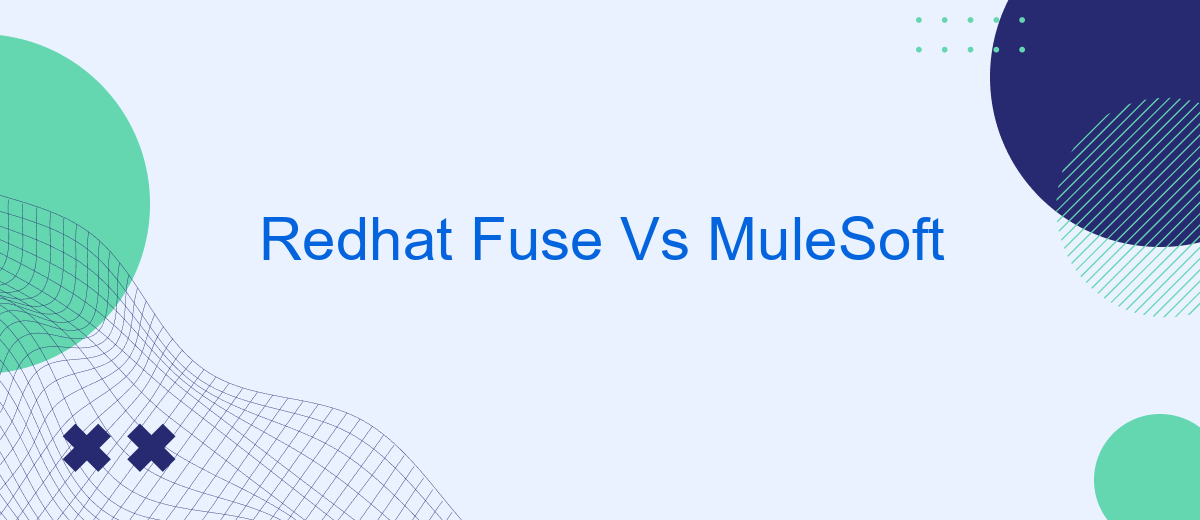When it comes to enterprise integration, choosing the right platform is crucial for seamless connectivity and efficient data management. Red Hat Fuse and MuleSoft are two leading contenders in this space, each offering unique features and capabilities. This article delves into a comparative analysis of Red Hat Fuse and MuleSoft, helping you make an informed decision for your integration needs.
Introduction
In today's rapidly evolving digital landscape, businesses are increasingly reliant on integration platforms to streamline their operations and enhance connectivity between disparate systems. Two prominent players in this space are Redhat Fuse and MuleSoft, each offering unique capabilities to meet diverse integration needs. Choosing the right platform can significantly impact an organization's efficiency and scalability.
- Redhat Fuse: Known for its open-source foundation and flexibility, Redhat Fuse is a robust solution for enterprises looking to integrate applications, data, and devices seamlessly.
- MuleSoft: A leading integration platform as a service (iPaaS), MuleSoft provides comprehensive tools to connect applications, data, and devices both on-premises and in the cloud.
Both platforms offer powerful features, but the choice depends on specific business requirements, such as scalability, ease of use, and support for various integration patterns. Additionally, services like SaveMyLeads can further simplify the integration process by automating lead data transfers between different systems, ensuring that businesses can maintain efficient workflows and focus on growth.
Capabilities Comparison

Redhat Fuse and MuleSoft are two prominent integration platforms that offer a range of capabilities to streamline and manage integrations. Redhat Fuse provides a robust, open-source integration framework that supports various protocols and data formats, making it highly adaptable for different enterprise needs. It focuses on microservices and container-based architectures, ensuring scalability and flexibility. MuleSoft, on the other hand, offers a comprehensive integration platform with a vast array of connectors and pre-built templates that simplify the process of connecting disparate systems. Its Anypoint Platform provides tools for API management, design, and analytics, making it a holistic solution for integration needs.
Both platforms excel in their areas, but MuleSoft's extensive library of connectors and user-friendly interface often make it the preferred choice for organizations seeking rapid deployment and ease of use. Redhat Fuse, with its emphasis on open-source technology, appeals to businesses that prioritize customization and control over their integration processes. Additionally, services like SaveMyLeads can further enhance these platforms by automating lead data transfer between various applications, ensuring seamless and efficient workflows. Ultimately, the choice between Redhat Fuse and MuleSoft will depend on the specific requirements and priorities of the organization.
Architecture and Integration

Red Hat Fuse and MuleSoft are two prominent integration platforms that cater to diverse enterprise needs. Red Hat Fuse is an open-source, distributed integration platform based on Apache Camel, which allows developers to create integration solutions using a wide array of connectors and components. MuleSoft, on the other hand, offers a comprehensive integration platform known as Anypoint Platform, which provides a unified solution to connect applications, data, and devices with its robust set of tools and connectors.
- Red Hat Fuse leverages a microservices architecture, enabling lightweight and flexible integration solutions.
- MuleSoft's Anypoint Platform utilizes an API-led connectivity approach, ensuring seamless integration across various systems and applications.
- Both platforms support cloud, on-premises, and hybrid deployments, offering versatility to meet different organizational requirements.
For businesses looking to streamline their integration processes, tools like SaveMyLeads can be highly beneficial. SaveMyLeads automates lead data processing and integrates seamlessly with various CRMs and marketing platforms, enhancing the efficiency of your integration solutions. Whether you choose Red Hat Fuse or MuleSoft, incorporating additional services like SaveMyLeads can significantly optimize your integration strategy.
Case Studies and Use Cases

Redhat Fuse and MuleSoft have been employed by various organizations to streamline their integration processes. Redhat Fuse, with its open-source foundation, has been particularly useful for companies looking for flexible and customizable integration solutions. MuleSoft, on the other hand, offers a robust API-led connectivity approach that has been beneficial for enterprises requiring extensive API management and integration capabilities.
One notable case study is a global retail company that utilized MuleSoft to integrate its e-commerce platform with multiple third-party services, enhancing customer experience and operational efficiency. Another example is a financial institution that adopted Redhat Fuse to integrate legacy systems with new cloud-based applications, significantly reducing operational costs and improving data flow.
- A healthcare provider using MuleSoft to connect electronic health records (EHR) with various health monitoring devices.
- A logistics company leveraging Redhat Fuse to streamline communication between its inventory management system and delivery tracking applications.
- An e-commerce business employing SaveMyLeads to automate lead generation and integration with CRM systems.
Both Redhat Fuse and MuleSoft offer unique advantages depending on the specific needs of the organization. While Redhat Fuse excels in environments requiring high customization, MuleSoft provides unparalleled API management and integration capabilities. Services like SaveMyLeads further enhance these platforms by automating lead integration processes, making them even more efficient and user-friendly.
Conclusion
In conclusion, both Redhat Fuse and MuleSoft offer robust solutions for integration needs, each with its unique strengths. Redhat Fuse is highly regarded for its open-source nature and flexibility, making it an excellent choice for organizations that prioritize customization and control over their integration processes. MuleSoft, on the other hand, excels in providing a comprehensive, user-friendly platform that simplifies the integration of various applications and data sources, making it ideal for businesses seeking rapid deployment and ease of use.
Ultimately, the choice between Redhat Fuse and MuleSoft depends on your organization's specific requirements and integration strategy. For businesses looking to streamline their integration processes further, tools like SaveMyLeads can complement these platforms by automating lead data transfer and ensuring seamless connectivity between marketing and sales applications. By carefully evaluating your needs and leveraging the right combination of tools, you can achieve efficient and effective integration solutions that drive business success.
FAQ
What are the core differences between Redhat Fuse and MuleSoft?
How do Redhat Fuse and MuleSoft handle API management?
Which platform offers better support for cloud-native applications?
Can I integrate third-party applications with Redhat Fuse and MuleSoft easily?
What are the options for automating and setting up integrations without extensive coding knowledge?
You probably know that the speed of leads processing directly affects the conversion and customer loyalty. Do you want to receive real-time information about new orders from Facebook and Instagram in order to respond to them as quickly as possible? Use the SaveMyLeads online connector. Link your Facebook advertising account to the messenger so that employees receive notifications about new leads. Create an integration with the SMS service so that a welcome message is sent to each new customer. Adding leads to a CRM system, contacts to mailing lists, tasks to project management programs – all this and much more can be automated using SaveMyLeads. Set up integrations, get rid of routine operations and focus on the really important tasks.
